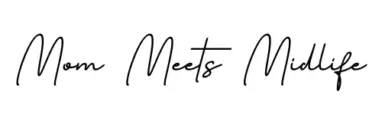Last Updated on March 17, 2023 by Erin

Ah, midlife. The time when mood swings and hot flashes collide to create a perfect storm of emotional chaos. One minute you’re feeling on top of the world, ready to conquer the day with your newfound confidence and wisdom. The next, you’re crying over a commercial for laundry detergent. It’s like living in a perpetual state of PMS, only now it’s called Peri-Menopause Syndrome. But fear not, fellow mid-lifers, for there is hope! With the help of these mood tracker ideas, you can monitor your moods, track your triggers, and hopefully avoid any emotional landmines. Let’s face it, nothing is more empowering than taking control of your midlife mood swings, one data point at a time.
**This post contains affiliate links. This means if you click and buy, I may receive a small commission (at zero cost to you). Please see my full disclosure policy for details.**
Printable Mood Tracker Ideas
A printable mood tracker is a type of chart or template that you can print out and use to track your mood over a period of time. The tracker usually includes different categories or descriptors to help you identify and record your emotional state on a given day, such as happy, sad, anxious, or stressed.
Printable mood trackers can come in various forms, such as a calendar format or a graph, and often include space for you to make notes about your day, such as events or activities that may have impacted your mood. They can be a helpful tool for individuals who want to monitor their mental health and identify patterns or triggers that affect their emotional well-being. It can also be helpful to share the information you collect with a mental health professional.
If you want to give printable mood trackers a try, I’ve created four different version that you can download for free.
Digital Mood Tracker Ideas
One of the easiest and most convenient ways to track your mood is by using a digital mood tracker. These apps allow you to input your mood throughout the day, along with any notes about what may have triggered your mood. There are a variety of mood tracking apps available, including Moodfit, Daylio, and Moodnotes.
Typically, mood tracking apps will prompt users to record their mood on a regular basis, such as once a day or several times throughout the day. Some apps may also allow users to set reminders to check in with their mood at specific times.
Once users have recorded their mood data, the app will often display this information in a graph or chart, allowing users to see how their mood has fluctuated over time. Many apps will also allow users to track additional data points, such as sleep patterns, exercise habits, and stress levels, which can provide further insights into how these factors impact their mood.
Journaling
Journaling is a classic mood tracking technique that has been used for centuries. By writing down your thoughts and feelings, you can better understand your emotional state and identify patterns over time. For midlife women, journaling can be especially helpful during periods of transition, such as menopause or retirement. Journaling can also be a great way to work through emotions related to relationships or family issues.
To use journaling as a mood tracker, individuals can start by setting aside time each day to write about their emotions and experiences. This could involve jotting down notes about how they feel in the moment, reflecting on the events of the day, or exploring any thoughts or feelings that are particularly prominent.
Over time, individuals can review their journal entries and look for patterns or trends in their mood. For example, they may notice that they tend to feel more anxious on days when they have a lot of work to do, or that they tend to feel happier after spending time with friends.
To make journaling as effective as possible as a mood tracker, individuals should be as honest and thorough as possible when recording their thoughts and feelings. They should also aim to write regularly, ideally on a daily basis, to ensure that they have a consistent record of their emotional experiences.
Meditation
While meditation does not provide a record of emotional experiences in the same way that journaling or mood tracking apps do, it can help individuals develop a deeper understanding of their emotional patterns over time. By regularly practicing meditation, individuals may become more adept at recognizing when their mood is shifting and identifying the factors that may be contributing to those changes.
Additionally, some meditation apps and programs may incorporate elements of mood tracking or monitoring. For example, they may ask users to rate their mood before and after a meditation session, or provide guided meditations designed to help individuals manage specific emotional states, such as anxiety or sadness.
Headspace is one such app that offers a variety of meditation and mindfulness activities while offering a way to track your mood and stress levels over time. I’ve been using the Headspace app for over 5 years and am a huge fan!
Gratitude Journals
Gratitude journals can be an effective way to track and monitor mood over time by focusing on positive emotions and experiences.
When someone keeps a gratitude journal, they typically record things they are grateful for, such as positive experiences, kind gestures from others, or things they appreciate in their life. By regularly reflecting on and recording these positive experiences, individuals can develop a greater sense of appreciation and gratitude, which can improve their overall mood.
Gratitude journals can also help individuals identify patterns and trends in their emotional experiences. For example, you may notice that on days when you record several things you are grateful for, you tend to feel happier and more content than on days when you do not practice gratitude.
To use a gratitude journal as a mood tracker, you can set aside time each day to reflect on positive experiences and record them in a journal. Over time, you can review entries and look for patterns in your emotional experiences, such as days or events that tend to elicit feelings of gratitude and positivity.
Exercise and Activity Trackers
Regular exercise is an important part of maintaining good physical and mental health, and it can also help improve your mood. Using an exercise or activity tracker, such as a Fitbit or Apple Watch, can help midlife women stay motivated to exercise and track their progress over time. Exercise can also be a great way to reduce stress and anxiety, which can contribute to mood disorders.
When someone uses an exercise or activity tracker, they typically record information about their physical activity, such as the type of activity, duration, and intensity. By tracking this information over time, individuals can gain insights into exercise habits and how they impact their mood and well-being.

Sleep Trackers
Getting enough sleep is essential for good mental health, and many midlife women struggle with sleep issues due to hormonal changes.
Sleep has been shown to have a significant impact on mood and mental health. Poor sleep quality or inadequate sleep can contribute to feelings of stress, anxiety, and irritability, while sufficient and restful sleep can improve mood and support overall mental and physical health.
By tracking your sleep patterns and monitoring how they impact your mood and overall well-being, you can develop a better understanding of how sleep influences your emotional experiences. This can help you identify areas where you may need to make changes to improve your sleep habits and support your mental health.
Using a sleep tracker, such as a smartwatch or a dedicated sleep tracker like the Circul ring, can help you better understand your sleep patterns and identify areas for improvement.
Food and Nutrition Trackers
Diet and nutrition can play a significant role in mood, and midlife women may benefit from tracking their food intake to identify any triggers. Food and nutrition trackers, such as MyFitnessPal, can help you track your calories, macros, and micronutrients. You can also track your mood and energy levels throughout the day to see if there are any patterns or correlations with your diet.
Certain foods and nutrients have been linked to improved mood and overall mental health. For example, there is promising research showing that omega-3 fatty acids, found in fatty fish, nuts, and seeds, can help reduce symptoms of depression. Similarly, consuming a balanced diet that includes a variety of fruits, vegetables, whole grains, and lean protein sources can support overall mental and physical health.
By tracking food intake and monitoring how it impacts your mood and overall well-being, individuals can gain insights into how diet is influencing mood. You can also identify areas where you may need to make changes to support your health.
Creative Outlets
Incorporating creativity into mood tracking can be a fun and creative way to monitor and manage emotions. Here are some creative mood tracker ideas:
- Art Journal: An art journal can be a personalized and creative way to track mood. Individuals can use art supplies, such as colored pencils, markers, or paint, to create visual representations of their emotional experiences.
- Collage: Creating a mood collage can be a fun and creative way to track emotions. Individuals can use magazine clippings, photographs, and other materials to create a visual representation of their mood over time.
- Doodle Diary: A doodle diary is a visual way to track mood through simple drawings or sketches. Individuals can create quick doodles or sketches that represent their emotional experiences throughout the day.
- Bullet Journal: A bullet journal can be a personalized and creative way to track mood, habits, and other aspects of daily life. Individuals can use art supplies, such as colored pencils, markers, or stickers, to create a visually appealing and informative tracker.
Final Thoughts
In this blog post, we’ve explored different ways that midlife women can track their moods, from journaling and gratitude practices to meditation and exercise trackers. We’ve also looked at how sleep and nutrition can impact our moods and discussed how tools like mood tracking apps and printable mood trackers can help us stay on top of our emotional ups and downs. By experimenting with different methods and finding what works best for us individually, we can navigate the oh-so-fun challenges of midlife with greater self-awareness.
Over to you- which of the mood tracking ideas will you try out? Let me know in the comments!
Sincerely,
Erin


